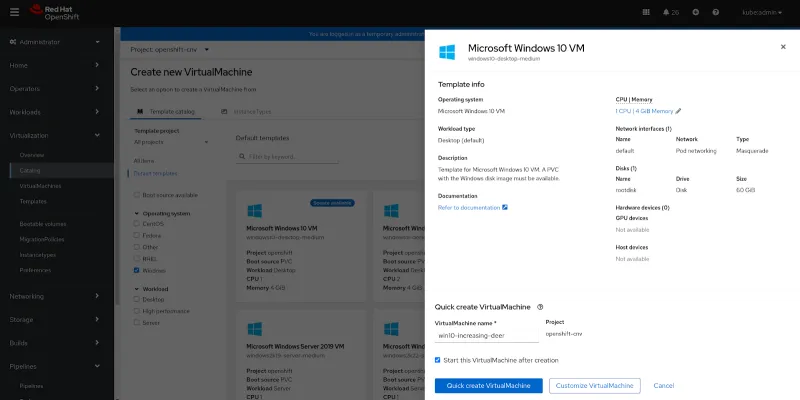Creating virtual machines (VMs) from golden images is a common practice. It minimizes the deployment time for new VMs and provides a familiar environment for the VM's owner. The admin benefits from creating golden images in an automated manner because it reflects the current configuration.
This blog post will show how to deploy KubeVirt Tekton tasks with example pipelines and how to run the windows-bios-installer pipeline. Prerequisites for this post are OpenShift (version 4.13), OpenShift Pipelines, and OpenShift Virtualization (version 4.13).
OpenShift Pipelines provides automation to create golden images for Windows VMs in OpenShift Virtualization.
Since this integration of OpenShift Virtualization with OpenShift Pipelines is still in tech preview, the OpenShift cluster administrator must enable it. Here's the command:
oc edit hco -n openshift-cnv kubevirt-hyperconverged
Set the spec.featureGates.deployTektonTaskResources field to true:
apiVersion: hco.kubevirt.io/v1beta1
kind: HyperConverged
metadata:
name: kubevirt-hyperconverged
spec:
featureGates:
deployTektonTaskResources: true

After the deployment succeeds, three example pipelines exist.
The example pipelines can be found through OpenShift administration under the Pipelines tab in the openshift-cnv namespace. Each pipeline can be triggered by clicking on the Options menu on the right side of the screen and then selecting the Start button. This starts the pipeline window, where the user must insert a URL to the Windows 10 ISO file.

Other pipelines will be described in a follow-up blog post. The windows-bios-installer pipeline shows how to create your own Windows 10 golden image with VirtIO drivers installed in the OpenShift cluster. The pipeline's only required parameter is a URL to a Windows 10 ISO file; all other parameters have default values, which can be changed.
In addition to the pipeline, an example sysprep answer file named autounattend.xml is deployed in a config map. This answer file works with Microsoft's Windows installation multi-edition ISO for English United States and x64. Users can apply their own customizations to the Windows image with the sysprep answer file, as seen here.
The pipeline consists of multiple steps:
- Downloading the Windows ISO into a PVC
- Creating a virtual machine that uses the sysprep answer file to install Windows
- Copying the resulting disk image into the default Windows 10 boot source of the cluster
The result of this pipeline is a DataVolume in the openshift-virtualization-os-images namespace. When a user wants a new Windows 10 VM, the VM will be created from this DataVolume without any additional configuration required.

Wrap up
You have seen how to use a sample pipeline to automatically deploy golden VM images in an OpenShift environment. Golden images are a critical part of deploying consistent and current VMs. Automating this process helps maintain that consistency.
About the authors
More like this
Looking ahead to 2026: Red Hat’s view across the hybrid cloud
Red Hat to acquire Chatterbox Labs: Frequently Asked Questions
Crack the Cloud_Open | Command Line Heroes
Edge computing covered and diced | Technically Speaking
Browse by channel
Automation
The latest on IT automation for tech, teams, and environments
Artificial intelligence
Updates on the platforms that free customers to run AI workloads anywhere
Open hybrid cloud
Explore how we build a more flexible future with hybrid cloud
Security
The latest on how we reduce risks across environments and technologies
Edge computing
Updates on the platforms that simplify operations at the edge
Infrastructure
The latest on the world’s leading enterprise Linux platform
Applications
Inside our solutions to the toughest application challenges
Virtualization
The future of enterprise virtualization for your workloads on-premise or across clouds
